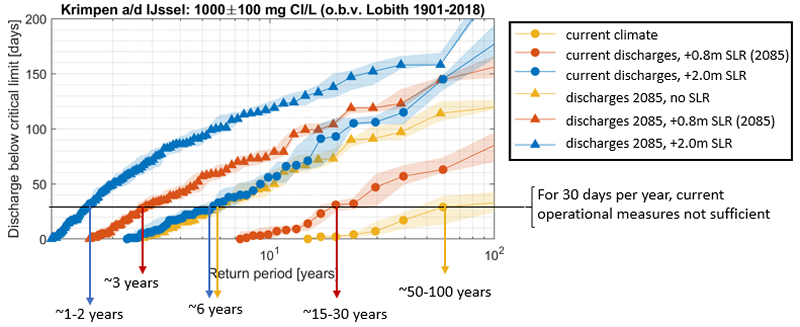Y. Huismans1,2*, L. Leummens1, S.C. Laan1, S.M.T. Rodrigo1, W.M. Kranenburg1,2, N. Kramer1, M. Mens1
1 Deltares; 2 Delft University of Technology
*corresponding author:
Abstract
Climate change is expected to cause sea level rise and both higher and lower river discharge extremes. The resulting increase in water depth and lower discharges will both enhance the surface water salt intrusion and reduce freshwater availability. To infer the impact of a changing discharge regime, ideally long timeseries of current and future discharge conditions are modelled (Mens et al., 2021). But in stratified systems, like the Rhine Meuse Estuary, computationally intensive 3D models are needed for a correct representation of the governing physical processes.
In this study, we developed a method to derive the combined impact of sea level rise and a changing discharge regime on salt intrusion based on a limited set of 3D simulations, with and without sea level rise. By combining this with the low-flow event probability (from a 100-year timeseries), the frequency and duration of the problematic salt intrusion events can be retrieved for both current climate and future projections.
Our results indicate that the impact of sea level rise and a changing discharge regime will lead to strong changes in return period of problematic salt intrusion events in the Rhine Meuse Estuary (high-end KNMI'14 projection for 2085), see figure 1. The probability of a problematic salt intrusion event is expected to increase from rare (once in 50-100 years) to frequent (once in a few years). The impact of the changing discharge regime is thereby larger than the impact of sea level rise. With the same method, we investigated the impact of a changing bed level and showed that the climate change impact is much larger than the impact of a bed level change of 1.0 m applied to the seaward 30 km section of the estuary. This implies that mitigation of salt-water intrusion by shallowing the entrance channel will require large bed level changes.

Figure 1: The impact of sea level rise and a changing discharge regime on the return times of salt intrusion events at one of the critical locations for fresh water in the Rhine Meuse Estuary. For sea level rise 0.8 m (high end KNMI'14 projection for 2085) and 2.0 m were taken. The discharge regime projection is based on high-end KNMI'14 projection for 2085 (Sperna Weiland et al., 2015).
References
Mens, M., Minnema, B., Overmars, K., van den Hurk, B. (2021) Dilemmas in developing models for long-term drought risk management: The case of the National Water Model of the Netherlands. Environmental Modelling & Software, 143, https://doi.org/10.1016/j.envsoft.2021.105100.
Sperna Weiland, F., Hegnauer, M., Bouazis, L., & Beersma, J.J. (2015). Implications of the KNMI'14 climate scenario for the discharge of the Rhine and Meuse; comparison with earlier scenario studies. Deltares report
I. Surname1*, F.N. Another-Surname2 , Y. Next-Surname2
1 University Name, Country; 2 Organization Name, Country
* Corresponding author: mail.name@organization.org


